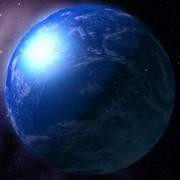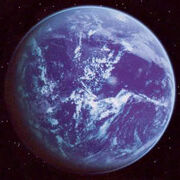
Manaan was a typical aquatic world
An ocean was a large body of liquid, usually water, although the lava fields of Mustafar were a notable exception. There were a number of planets that were composed entirely of oceans, like Dac and Manaan. Certain ice planets also had a liquid ocean under the layers of ice, due to core heating, such as Helska IV.
Impact
Oceans generally had a significant part to play on a planet's ecosystem, depending on the type of climate the particular world in question had, and affect the habitability of the world for most species in general. However, it was by no means a mark of ability to sustain life. Despite the lack of significant bodies of water, arid worlds, such as Tatooine[1] were still able to sustain life through the use of moisture vaporators,[2] albeit in a more limited fashion. However, not all such worlds used moisture vaporators; on Cona, the native Arcona harvested water from plant pods.[3] The presence of water, or lack thereof, could possibly have had a major impact on the species inhabiting that world. On the dry and arid world of Kamar, an organization called the Cult of Varn existed, which held a understandably particular reverence for water.[4]
Biology of aquatic species
Some oceans in particular, were full of a variety of lifeforms. For example, the waters of the oceanic world of Dac,[5] better known as Mon Calamari to Humans and the rest of the known galaxy, have produced no less than five different sentient species,[6][7] including the whale-like Whaladons.[8] Aquatic species, such as the Mon Calamari and the Quarren, generally did not enjoy being in a particularly arid environment, and preferred to be in a humid environment. The quarters of Jedi Master Bant Eerin were constantly kept misty and humid.[9]
Hazards
Pollution was sometimes a problem for aquatic-based creatures and species. In the event of an industrial accident, currents would spread pollutants and other hazardous material fairly quickly, depending on the scale of the accident or size of the oceans. On ocean covered planets, this potentially had large and disastrous ramifications, with far reaching consequences. The aquatic[10] planet of Manaan was the sole producer of kolto, a healing fluid generally believed to be produced with the aid of the Progenitor.[11]
History

Kamino became an oceanic world in 19,000 BBY
A planet could be submerged under an ocean by a climate change; this was the case with Kamino, which underwent the so-called "Great Flood in 19,000 BBY.[12] Due to the fragile nature of their home waters, aquatic species tended to be very environmentally conscious, although that was not a trait unique to marine species; Ergesh[13] and Alderaanians were a few groups of beings that took great care of their natural environments. Conversely, on Coruscant, all natural bodies of water were drained and stored to provide for the multitudes of beings that called it home.[12] The largest body of water, the artificial Great Western Sea, was the only remaining such body of water and was used as a tourist destination prior to the fall of Coruscant,[14] while afterwards it became a succession pool.[15] During the Second Imperial Civil War, under the guise of it being Darth Krayt's wishes, Darth Wyyrlok (III) ordered the immediate destruction of Dac's ecosystem, with the desire to render the entire planet unsuitable for life at the hands of Vul Isen's viral spores as a part of the Final Protocol. It succeeded in poisoning the waters of the world within a week, killing billions and concluded the Genocide of Dac,[16] rendering the world uninhabitable.
Behind the scenes
In the computer game Star Wars: Knights of the Old Republic, a dark side option for the player exists, where Revan would pump a toxin into the water, thereby destroying the entire production of kolto, planet-wide, affecting medicine prices as it was used widely before the introduction of bacta.[11]
Sources
- Star Wars: Empire at War: Forces of Corruption: Prima Official Game Guide
- Coruscant and the Core Worlds
- Han Solo and the Corporate Sector Sourcebook
- Geonosis and the Outer Rim Worlds
- Manaan: Depths of History
- The Jedi Path: A Manual for Students of the Force
 Tatooine in the Databank (content now obsolete; backup link)
Tatooine in the Databank (content now obsolete; backup link) Bal'demnic in the Databank (content now obsolete; backup link)
Bal'demnic in the Databank (content now obsolete; backup link)
Notes and references
|
